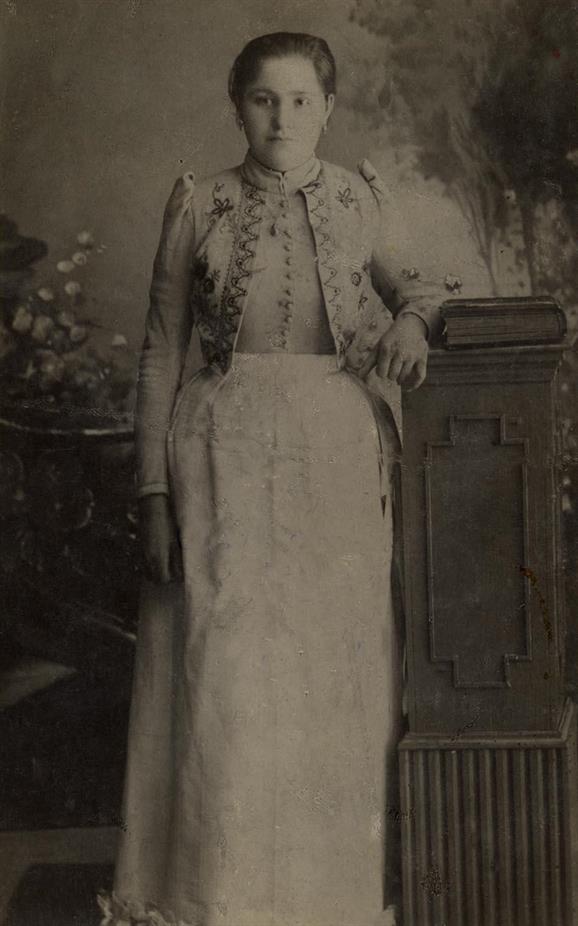
Esther Ita Stampfer, Petah Tikva, Eretz Israel, early 20th century, Esther Ita wife of Shlomo Yitzchak Stampfer, died of maternal fever three days after giving birth, leaving behind five orphans. Ester Ita is the grandmother of Zehava Ben-Dov nee Stampfer, Shlomo-Yitzhak Stempfer married Esther Ita, daughter of Hezekiah Jacob and Golda Rosenthal Danziger. Esther died in the year 1914. Rabbi Yehoshua Stampfer (born 8 June 1852, Komárno?, Szombathely, Hungary – died 4 July 1908) was one of the founders of the of the city Petah Tikva also known as Em HaMoshavot and one of the founders of The Religious Zionist Party - HaTzionut HaDatit.
With the growing of the Orchards in Petach Tikva and the other places in Eretz Israel, Yehoshua Stampfer came up with the idea of establishing an association - a marketing system for Citrus fruit abroad, and the "Pardes" association was established in 1901, the first association in Eretz Israel for Citrus fruit marketing.
The Oster Visual Documentation Center, ANU – Museum of the Jewish People, Courtesy of Stampfer Family (Ben Dov)
STAMPFER
(Family Name)Surnames derive from one of many different origins. Sometimes there may be more than one explanation for the same name. This family name is a toponymic (derived from a geographic name of a town, city, region or country). Surnames that are based on place names do not always testify to direct origin from that place, but may indicate an indirect relation between the name-bearer or his ancestors and the place, such as birth place, temporary residence, trade, or family-relatives.
This name is derived from the town of Stampfen in Slovakia, formerly part of Hungary.
BEN-DOV
(Family Name)Surnames derive from one of many different origins. Sometimes there may be more than one explanation for the same name.
The literal meaning of Ben-Dov is "son of the bear". Dov is the Hebrew for "bear", an equivalent of the German Baer.
This family name may be a toponymic (derived from a geographic name of a town, city, region or country). Surnames that are based on place names do not always testify to direct origin from that place, but may indicate an indirect relation between the name-bearer or his ancestors and the place, such as birth place, temporary residence, trade, or family-relatives.
As an Ashkenazi name, it could have been taken from one of the house-signs that were familiar sights in German towns, particularly Frankfurt am Main, in the Middle Ages, for instance 'Zum Goldenen Baeren' ("to the Golden Bear"). The Jewish surname Baer is documented in the city since the early 16th century. Its closest biblical association is traced to Issachar (Genesis 49.14), whom Jacob compares to a large-boned ass, a symbol of hard work and strength. Because 'donkey' was a derisive term in Europe, the Jews living there replaced it with another animal embodying great strength and endurance, the bear, whose old German name is linked to 'man, hero and prince'. One form of this Jewish family name, Beer, is documented in the 15th century in Italy with the scholar Benjamin Ben Elijahu Beer; Baer is recorded in Frankfurt am Main, Germany, in 1530; Bermann in 1548 in Hesse, Germany; Behrmann in the German town of Fuerth in 1708; Behr in Westhoffen, eastern France, in 1720; Baer in Paris in 1756; and Baehr, Berr and Ber in France at the end of the 18th and the beginning of the 19th century. Berl, a diminutive of Baer, is identical with an abbreviation of Ben Reb Leser and the possible source of several family names, among them Perl (German for "pearl") mentioned with Sara Perl of Prague in 1684, Berels and Berelson, and sometimes Berlin (a form coinciding with the name of the German city).
Distinguished 20th century bearers of the Jewish surname Ben-Dov include the Israeli diplomat David Ben-Dov.
Szombathely
(Place)German: Steinamanger
A city in western Hungary
Szombathely is the oldest city in Hungary, and one of the largest. It is located near the border with Austria, where the Lower Alps meet the Little Hungarian Plain.
Szombathely has a small Jewish community, which maintains a small prayer house and a cultural center.
A Jewish history museum and visitors’ center were opened in 2013, and feature information about the history of the Jews of Szombathely.
Szombathely’s synagogue, which was originally built in 1880, is used as a concert hall. A Holocaust memorial is located next to the synagogue building.
HISTORY
The Jewish community of Szombathely was a first organized as a branch of the Jewish community of Rechnitz (Rohonc). Though Jews lived and worked there as merchants beginning in 1687, it was only in 1840, after Jews throughout the Austro-Hungarian Empire were granted the freedom of settlement, that they were they permitted to settle in Szombathely permanently.
A German-language school was established in 1846; the language of instruction was changed to Hungarian in 1861. The community had two synagogues; the older synagogue was used by the Orthodox members of the community, while a new synagogue was built in 1880.
Rabbis who served the Jewish community of Szombathely included l. Koenigsberger and J. Horovitz, the latter of whom was deported by the Nazis during World War II (1939-1945) and returned to the city and to his role as the community’s rabbi after the war.
The Jewish population was 59 in 1840. By 1869 it had grown substantially, to 1,154. In 1880 there were 1,678 Jews living in Szombathely, and 1,639 in 1890. In 1900 the city’s Jewish population was 2,635.
THE HOLOCAUST
After the Germans occupied Hungary on March 19, 1944, about 4,220 Jews were deported to Auschwitz. 400 survived.
POSTWAR
Approximately 250 survivors returned to Szombathely after the war. Together with Jews from the surrounding areas, they numbered 753 in 1946. By 1970 there were less than 80 Jews remaining in Szombathely.